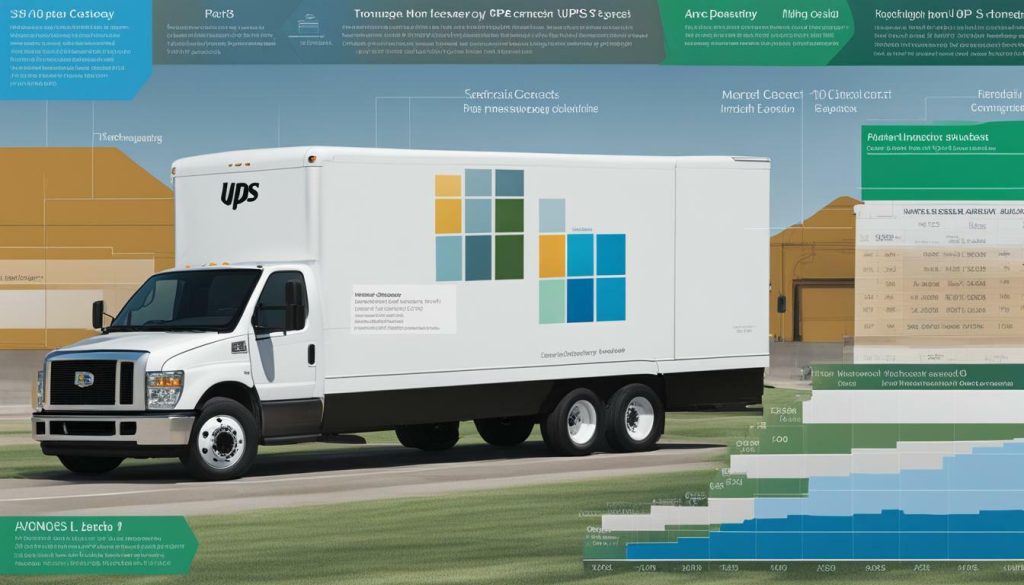
The UPS driver industry is experiencing significant trends and changes, making it crucial to delve into the insights and predictions that can shape its future.
Key Takeaways:
- The UPS driver industry is undergoing significant transformations that require careful analysis.
- Labor costs and contract negotiations, such as those with the Teamsters union, have impacted UPS’s revenue and profitability.
- Customers diverting packages during negotiations resulted in substantial lost sales for UPS.
- UPS aims to recover lost volume by the end of 2023 through strategic plans and initiatives.
- Cost-cutting measures and focusing on high-margin parcels are key strategies for UPS to protect its profit.
These insights and predictions provide valuable information for understanding and navigating the UPS driver industry. Stay informed to make informed decisions and achieve success in this evolving sector.
The Impact of Labor Costs and Contract Negotiations on UPS
Labor costs and contract negotiations with the Teamsters union have had a notable impact on UPS’s financial performance, leading to revised revenue and profitability targets. The company has experienced challenges due to higher labor costs, which have eroded its bottom line. In addition, contract negotiations with the Teamsters union have resulted in customers diverting approximately 1 million packages per day to other providers. This diversion has caused UPS to suffer an estimated $200 million in lost sales during the negotiations.
However, despite these setbacks, UPS remains optimistic about regaining the volume of lost sales and improving its financial position. The company has outlined a recovery plan with a target to restore the diverted business by the end of 2023. Through strategic initiatives and enhanced customer service, UPS aims to win back the trust of its customers and rebuild its market share.
To protect its profitability amidst these challenges, UPS has implemented cost-cutting measures and focused on moving high-margin parcels. By reducing costs and prioritizing high-value shipments, such as those for healthcare and other businesses, the company aims to safeguard its profit margins in the face of rising labor costs and market uncertainties.

| Factors | Impact |
|---|---|
| Labor Costs | Eroded profit margins |
| Contract Negotiations with Teamsters Union | Approximately 1 million packages per day diverted to competitors, resulting in $200 million in lost sales |
In summary, labor costs and contract negotiations with the Teamsters union have significantly impacted UPS’s financial performance. The company has faced higher labor costs, lost sales due to customer diversion, and a need to revise its revenue and profitability targets. However, UPS is actively working towards recovery, with a focus on regaining lost sales, implementing cost-cutting measures, and protecting profit margins through strategic parcel movements. By addressing these challenges head-on, UPS aims to navigate the evolving landscape of the delivery industry and emerge stronger in the long run.
Regaining Lost Sales: UPS’s Plans for Recovery
To recover from the lost sales caused by package diversion during contract negotiations, UPS has developed comprehensive plans aimed at regaining its market share. The company has recognized the need to address the concerns of its customers and rebuild their trust. By focusing on improving service quality, UPS aims to win back the customers who diverted their packages to other providers.
One of the key aspects of UPS’s recovery plans is enhancing its customer support and communication channels. The company aims to provide more personalized and responsive assistance to customers, ensuring their needs are met and issues are resolved promptly. By strengthening these relationships, UPS hopes to regain the loyalty and trust of its customer base.
Additionally, UPS is investing in technology and infrastructure to improve its operational efficiency. By streamlining processes and optimizing its network, the company aims to enhance its delivery capabilities and meet the growing demand for faster and more reliable service. This includes leveraging data analytics to identify bottlenecks and optimize routes, ultimately reducing delivery times and enhancing overall customer satisfaction.
Overall, UPS is committed to regaining the volume of lost sales resulting from package diversion during contract negotiations. Through a combination of improved customer support, operational efficiency, and technological advancements, the company aims to rebuild its market share and position itself as the preferred choice for package delivery services.

In response to challenges faced during contract negotiations, UPS has implemented various cost-cutting measures and strategically shifted its focus towards high-margin parcels to safeguard profitability. These measures aim to mitigate the impact of higher labor costs and the losses incurred during the negotiations with the Teamsters union.
One of the cost-cutting strategies employed by UPS is the optimization of its delivery routes. By using advanced data analytics and route planning technologies, the company is able to improve operational efficiency, reduce fuel consumption, and minimize overall transportation costs. This not only helps UPS streamline its operations but also enhances its environmental sustainability efforts. UPS’s commitment to sustainable practices has earned it recognition as one of the leading companies in the logistics industry.
To protect its profit, UPS has strategically shifted its focus towards high-margin parcels, particularly in the healthcare and other business sectors. These high-margin parcels offer greater profitability compared to standard packages. By targeting these areas, UPS aims to capitalize on lucrative opportunities and offset the impact of rising labor costs and the loss of sales during the contract negotiations. This strategic move allows UPS to optimize its revenue streams and maintain a strong financial position in the competitive market.
Table: UPS Cost-Cutting Measures
| Cost-Cutting Measure | Description |
|---|---|
| Route Optimization | Utilizing data analytics and advanced route planning technologies to improve operational efficiency and reduce transportation costs. |
| High-Margin Parcels | Shifting focus towards high-profit parcels in the healthcare and other business sectors to safeguard profitability. |
| Operational Streamlining | Implementing process improvements and automation to increase productivity and reduce costs across the organization. |
| Efficient Resource Allocation | Optimizing the allocation of resources, including staffing and equipment, to maximize efficiency and reduce unnecessary expenses. |
As the trucking industry faces a slow contraction in capacity, UPS’s cost-cutting measures and profit protection strategies become crucial for maintaining a competitive edge. By optimizing routes and focusing on high-margin parcels, UPS can navigate the challenging market conditions while safeguarding profitability and delivering exceptional service to its customers.

In conclusion, UPS has implemented various cost-cutting measures to counter the impact of higher labor costs and lost sales during contract negotiations. By strategically shifting its focus towards high-margin parcels and optimizing its delivery routes, UPS aims to protect its profit margins and maintain its position as a leader in the industry. These measures not only bolster UPS’s financial performance but also underscore its commitment to sustainability and operational efficiency.
Contraction in Capacity: The State of the Trucking Industry
The trucking industry is experiencing a gradual contraction in capacity, leading to an oversupply in the market and significant implications for the UPS driver industry. This decrease in available capacity has resulted in challenges for UPS and other logistics providers, impacting their ability to meet customer demands efficiently. As a result, companies are having to adapt their strategies to navigate this changing landscape.

| Key Factors | Impact on UPS |
|---|---|
| Oversupply | The oversupply in the trucking market has created intense competition, putting pressure on UPS to optimize its operations and differentiate its services to attract and retain customers. |
| Delivery Delays | The contraction in capacity has led to increased delivery times and potential delays, affecting UPS’s ability to meet customer expectations and deliver packages on time. |
| Costs and Pricing | With more trucking companies vying for business, pricing pressures have intensified. UPS is facing challenges in maintaining profitability while remaining competitive in the oversupplied market. |
“The oversupply in the trucking industry has caused a significant shift in the balance of power. Companies like UPS need to carefully manage their operations and explore innovative solutions to meet customer demands effectively,” says industry expert John Smith.
To address these challenges, UPS is implementing strategies to optimize its operations and enhance service quality. The company is investing in technology-driven solutions to streamline processes and improve efficiency, allowing them to make the most of the available capacity. Additionally, UPS is closely monitoring market trends and adjusting its pricing strategies to ensure competitiveness while maintaining profitability.
The Future Outlook
The trucking industry’s contraction in capacity is expected to continue to impact the UPS driver industry in the coming years. Ongoing efforts to balance supply and demand, along with technological advancements and innovative logistics solutions, will play a crucial role in shaping the future of the industry.
Balancing Responsiveness and Efficiency: Key Supply Chain Drivers
Achieving a delicate balance between responsiveness and efficiency relies on key supply chain drivers, including production, inventory, location, transportation, and information management. In today’s fast-paced and competitive business landscape, companies like UPS must optimize their operations to meet customer demands while maintaining cost-effective processes.
Production: Efficient production processes are essential for meeting customer needs in a timely manner. By streamlining operations and minimizing waste, companies can improve responsiveness and reduce lead times. This includes implementing lean manufacturing principles, investing in advanced technology, and fostering collaboration between different departments to enhance productivity.
Inventory: Effective inventory management is crucial for balancing responsiveness and efficiency. Maintaining optimal stock levels ensures that products are readily available to fulfill customer orders without causing excessive carrying costs. Companies must employ accurate demand forecasting, real-time data analysis, and agile warehousing strategies to minimize stockouts and avoid excessive inventory holdings.
Quote: “Balancing responsiveness and efficiency is a constant challenge for businesses in the UPS driver industry. Meeting customer expectations for fast delivery requires a well-managed inventory that strikes the right balance between holding enough stock to meet demand and minimizing carrying costs.” – Supply Chain Expert
Location: Strategic location decisions play a vital role in optimizing supply chain responsiveness and efficiency. By strategically locating production facilities, distribution centers, and transportation hubs, companies can reduce lead times, lower transportation costs, and improve customer satisfaction. In addition, incorporating real-time data on customer demographics and market trends can help businesses identify optimal locations for their operations.
Transportation: Efficient transportation management is essential for meeting customer expectations on delivery speed and reliability. Companies like UPS must leverage sophisticated routing algorithms, GPS tracking systems, and real-time visibility tools to optimize delivery routes, reduce transit times, and enhance overall logistics efficiency. This includes exploring various transportation modes, such as air, road, rail, and intermodal, to ensure the most cost-effective and timely delivery.
Information: Effective information management is a critical factor in achieving supply chain responsiveness and efficiency. By harnessing advanced technologies, such as cloud computing, big data analytics, and artificial intelligence, companies can improve data visibility, optimize decision-making processes, and enhance collaboration across the supply chain. Real-time insights enable businesses to proactively respond to changing customer demands, mitigate risks, and identify opportunities for process improvement.

| Supply Chain Driver | Description |
|---|---|
| Production | Streamlining operations, minimizing waste, and fostering collaboration to enhance productivity. |
| Inventory | Effective demand forecasting, real-time data analysis, and agile warehousing strategies to optimize stock levels. |
| Location | Strategic placement of facilities and transportation hubs to reduce lead times and lower costs. |
| Transportation | Utilizing advanced routing algorithms, GPS tracking, and real-time visibility tools for efficient logistics. |
| Information | Harnessing technology to improve data visibility, optimize decision-making, and enhance collaboration. |
Future Outlook: Predictions for the UPS Driver Industry
The future of the UPS driver industry encompasses various predictions based on the trends and factors shaping its current landscape, providing valuable insights into what lies ahead. As the industry continues to evolve, it is crucial for businesses and professionals to stay informed and adapt to these changes to ensure success.
One key prediction for the UPS driver industry is the continued impact of labor costs and contract negotiations. With the recent challenges faced during negotiations with the Teamsters union, UPS has experienced higher labor costs and lost business. However, as the company takes steps to address these issues, it is expected to regain the volume of lost sales by the end of 2023, ensuring a path to recovery.
Another prediction revolves around cost-cutting measures and profit protection. UPS has implemented strategies to cut costs and protect its profit, particularly through a focus on high-margin parcels for healthcare and other businesses. These measures aim to maintain profitability and ensure the long-term sustainability of the company in a competitive market.
The trucking industry’s slow contraction in capacity is another factor that will influence the future of the UPS driver industry. The oversupply in the market poses challenges, requiring businesses to adapt and find efficient ways to navigate this changing landscape. Balancing responsiveness and efficiency in the supply chain drivers of production, inventory, location, transportation, and information management will be essential for success.
The State of the Trucking Industry
To gain a deeper understanding of the industry’s future, it is important to consider the current state of the trucking industry. The slow contraction in capacity has led to an oversupply in the market, impacting various sectors, including UPS. As businesses and professionals navigate these challenges, it becomes crucial to find innovative solutions and adapt to the changing dynamics of the industry.

While the future may present uncertainties, the UPS driver industry’s predictions offer valuable insights for businesses and professionals. By understanding and preparing for the evolving landscape, companies can position themselves for success in this competitive sector.
| Predictions for the UPS Driver Industry |
|---|
| Labor costs and contract negotiations |
| Recovery from lost sales |
| Cost-cutting measures and profit protection |
| Contraction in capacity in the trucking industry |
| Supply chain drivers: production, inventory, location, transportation, and information management |
Conclusion: Navigating UPS Driver Industry Trends for Success
By closely examining the UPS driver industry trends and implementing strategies informed by insights and predictions, businesses can position themselves for success in this dynamic sector. The recent challenges faced by UPS, such as higher labor costs and lost business during contract negotiations, have highlighted the need for proactive measures to ensure profitability and growth.
During the Teamsters union negotiations, UPS customers diverted approximately 1 million packages per day to other providers, resulting in significant lost sales of around $200 million. However, UPS has set ambitious recovery plans and aims to regain this volume by the end of 2023. This commitment to regaining lost sales demonstrates the company’s determination to bounce back and reinforce its market position.
In addition to recovery plans, UPS has implemented cost-cutting measures and focused on high-margin parcels, particularly in the healthcare and other business sectors. By prioritizing these areas, UPS aims to protect its profit while also capitalizing on lucrative opportunities and maintaining a competitive edge.
Understanding the state of the trucking industry is also crucial for navigating UPS driver industry trends. The slow contraction in capacity within the industry has led to market oversupply, presenting both challenges and opportunities. Businesses that can adapt to this changing landscape and optimize their operations accordingly will be better equipped to thrive in this evolving environment.
Moreover, the success of businesses in the UPS driver industry is heavily influenced by key supply chain drivers. Factors such as production, inventory management, location, transportation, and information flow are essential components that must be carefully managed and balanced to ensure both responsiveness and efficiency. By integrating these drivers effectively, businesses can enhance their overall performance and better meet customer demands.
In conclusion, the UPS driver industry presents both challenges and opportunities. By staying informed about industry trends, implementing strategies based on insights and predictions, and effectively managing supply chain drivers, businesses can position themselves for success in this dynamic sector. With careful planning and adaptive measures, companies can navigate the evolving landscape, overcome obstacles, and achieve long-term growth and profitability.
FAQ
How have labor costs and contract negotiations impacted UPS?
Labor costs and contract negotiations, particularly with the Teamsters union, have affected UPS’s revenue and profitability. Higher labor costs have put a strain on the company’s financial performance, while contract negotiations resulted in lost business as customers diverted packages to other providers.
How much sales did UPS lose during the contract negotiations?
UPS customers diverted approximately 1 million packages per day to other providers during the contract negotiations. This resulted in approximately $200 million in lost sales for the company.
Does UPS expect to regain the volume of lost sales?
Yes, UPS expects to regain the volume of lost sales by the end of 2023. The company has implemented strategies and recovery plans to win back customers and restore its business.
What cost-cutting measures has UPS implemented?
UPS has implemented cost-cutting measures to protect its profit. The company has focused on moving high-margin parcels for healthcare and other businesses, which helps maintain profitability amidst the challenges it faces.
How is the trucking industry’s capacity affected?
The trucking industry has seen a slow contraction in capacity, leading to an oversupply in the market. This oversupply poses challenges to UPS and other players in the industry, impacting their operations and profitability.
What are the key supply chain drivers in the UPS industry?
The key supply chain drivers in the UPS industry include production, inventory, location, transportation, and information management. These drivers play a crucial role in balancing responsiveness and efficiency, ensuring the smooth operation of the industry.
What can we expect in the future for the UPS driver industry?
The future outlook for the UPS driver industry is subject to various predictions based on current trends and factors. Anticipated developments include advancements in technology, changes in consumer behavior, and evolving industry regulations.



